Production Year 2012
 The Mark of Beauty | The Bento
The Mark of Beauty | The Bento
DC331215![]()
美の壺 | 弁当 [NHK]
![]()
![]()


|Length : 29min. |Year : 2012 |
The gentle autumn season is perfect for picnics and excursions, and what better way to compliment the splendor of the season than a nice boxed bento meal? The wide array of colorful side dishes carefully arranged in the small box is a beauty unique to Japan. We will get a close look at the presentation techniques of Kyoto's made-to-order "Shidashi Bento", the origins of the "Shokado Bento" which are rooted in the Japanese tea ceremony, and a behind the scenes look at the preparation of the "Makunouchi Bento" which have been enjoyed at Japanese Kabuki plays for decades. Loaded with bento fun-facts and imagery that are sure to whet your appetite, we will try to get a better understanding of the Japanese aesthetics that are packed into the bento box.
 The Mark of Beauty | Sashimi
The Mark of Beauty | Sashimi
DC331216![]()
美の壺 | 刺身 [NHK]
![]()
![]()


|Length : 29min. |Year : 2012 |
One of the dishes that the Japanese are most acquainted with is the sashimi. To say that sashimi is "just cutting raw fish" would be ignorant. Since its birth in the Heian Period roughly 1,000 years ago, it has been passed down through generations of chefs, with the technique being refined to an art form. We will take a look at the superb knife skills of a master and the secret to plate selection in creating awe-inspiring presentation. We will also take a look at sashimi specific to different regions in order to fully understand and appreciate its simplistic beauty.
Great East Japan Disaster : Akiko’s First 30 Days
DC371207![]()
NNNドキュメント‘11 津波にのまれた女将 [TVI]
![]()
![]()
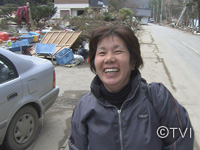
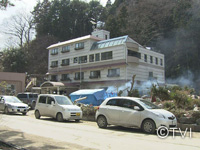
|Length : 24min. |Year : 2012 |
Akiko Iwasaki (age 54) lives by the sea near Kamaishi City in Iwate Prefecture. The inn she owns and operates is hit by the tsunami, destroying the entire first floor. Just then, Ms. Iwasaki was running through the parking lot to escape up the hill but was overcome by the wave. She talks of how she was sucked under like a whirlpool, all went dark and she calmly thought about how she was going to die like this. But then she tried swimming, clambered up to the surface, and was saved by a hairsbreadth.
She opens her ruined inn to 20 plus refugees, supplying her own food stocks and working hard, turning her place into a private evacuation shelter. Next the ruined inn is deemed hazardous for refugee living, and she receives an official order to shut down by the end of March. Akiko Iwasaki, the innkeeper who was sucked under by the tsunami and barely escaped with her life, is now, beyond her will, forced into transience.
Pass Down The Great Earthquake Experience
DC371208![]()
ともにエピソード それぞれのありがとう [OX]
![]()
![]()
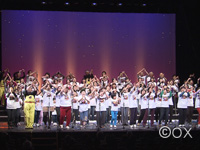
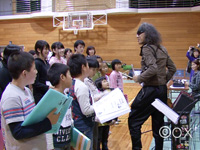
|Length : 33min. |Year : 2012 |
When the Great East Japan earthquake and tsunami hit Higashi-Matsushima in Miyagi Prefecture, over 1,100 of the 40,000 residents lost their lives. A project began in the summer of 2011: the Higashi-Matsushima survivors would create a musical. The goal was to express their gratitude for the aid received after the disaster. In November 2011, a hundred people gathered to create a musical for the Tokyo stage.
The project was started by Yoriko Ando who lost her high-school daughter in the tsunami, and by Hiroshi Maetani and his wife, who lost their home. They were joined by Tokyo director Tateo Teramoto. Work began on the musical before the script was written. Teramoto asked the survivors about their experiences and based his script on what he heard. The cast practiced singing and dancing as Teramoto collected a wide variety of stories. One man bitterly regrets that all he could do for his parents' bodies was wash them in a bottleful of water. A high-school student watched helplessly as his house went up in flames. There were powerful, life-affirming stories as well. 100 different experiences of the disaster went into the musical script. But although Ando helped start the project, she cannot speak of her dead daughter to the others. Each survivor comes to terms with the tragedy through the musical.
After five months of work, the show is staged in March 2012 in Tokyo. The 2,000-strong audience make it a huge success. What was the finished musical like? How did this experience change the survivors? A hundred survivors make sense of the disaster and of their future.
When the Great East Japan earthquake and tsunami hit Higashi-Matsushima in Miyagi Prefecture, over 1,100 of the 40,000 residents lost their lives. A project began in the summer of 2011: the Higashi-Matsushima survivors would create a musical. The goal was to express their gratitude for the aid received after the disaster. In November 2011, a hundred people gathered to create a musical for the Tokyo stage.
The project was started by Yoriko Ando who lost her high-school daughter in the tsunami, and by Hiroshi Maetani and his wife, who lost their home. They were joined by Tokyo director Tateo Teramoto. Work began on the musical before the script was written. Teramoto asked the survivors about their experiences and based his script on what he heard. The cast practiced singing and dancing as Teramoto collected a wide variety of stories. One man bitterly regrets that all he could do for his parents' bodies was wash them in a bottleful of water. A high-school student watched helplessly as his house went up in flames. There were powerful, life-affirming stories as well. 100 different experiences of the disaster went into the musical script. But although Ando helped start the project, she cannot speak of her dead daughter to the others. Each survivor comes to terms with the tragedy through the musical.
After five months of work, the show is staged in March 2012 in Tokyo. The 2,000-strong audience make it a huge success. What was the finished musical like? How did this experience change the survivors? A hundred survivors make sense of the disaster and of their future.
Bouncing Back with Family Ties
DC371209![]()
イチゴがつなぐ家族の絆 [OX]
![]()
![]()
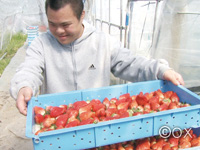
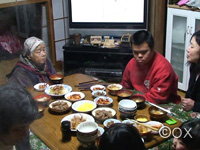
|Length : 24min. |Year : 2012 |
Yamamoto in Miyagi Prefecture was Tohoku's biggest strawberry-growing region. Nearly all of the 130 strawberry farmers' holdings were destroyed in the Great East Japan earthquake and tsunami. Takao Kanno has spent over 40 years growing strawberries. He lost both his home and greenhouses.
The four generations and eight members of the Kanno family all survived. But no big family can survive without an income. Takao quickly rented land from friends to begin growing strawberries again. Nine months after the disaster he reaps a harvest. Yet he cannot rely on borrowed land for future seasons. He hopes to rebuild a big greenhouse on the same spot as the old one and set up a strawberry farm for visitors. It will cost about 20 million yen. When added to the cost of rebuilding the family home the Kannos are looking at enormous debts.
Takao's son, Takaaki is focusing on construction work to earn money for the family. But a delay in rebuilding the greenhouse threatens next year's harvest. Takao insists that rebuilding is more important in the long term than earning money now. The two men also argue over the site of the new home. It isn't easy for the two to reach mutual agreement.
Meanwhile strawberry farmer Hiroyuki Suzuki is from the nearby town of Watari. He and his family have moved to Hokkaido to begin growing strawberries there. They chose the security of a daily wage and housing aid to help raise their two young children.
The second spring since the disaster dawns.
Takaaki's oldest son Shohei has Down syndrome. His dislike of strawberries meant he couldn't even tolerate their smell. Yet he starts to lend a hand in the greenhouse in order to help his family. Takaaki takes time off work to focus on rebuilding the greenhouses. Shohei's two little sisters have also begun to help out where they can. The Kanno family come together to rebuild greenhouses on the site of their old farm. Having weathered disaster, their family bond has grown even tighter.














